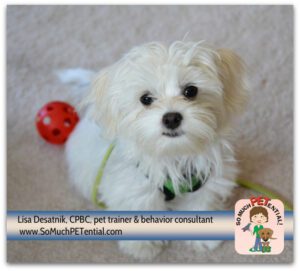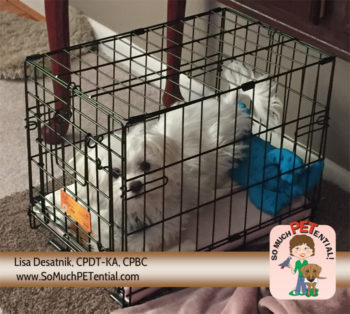Commonly, people who are having trouble teaching their puppy a proper potty area, or who are having problems with their puppy chewing on things not meant for puppy teeth, also happen to be people who do not use a crate – or practice good management.
 The problem is prevention of practicing unwanted behavior while teaching wanted habits and behavior is absolutely critical when it comes to setting your puppy up for success. After all, he was not born understanding your house rules. He has mental and physical needs and will find ways to get those needs met in either acceptable or unacceptable ways (according to your perspective anyway). Without the management component, your puppy may choose to do behaviors you do not like but the reinforcement he gets from his environment for doing them is going to create long lasting habits.
The problem is prevention of practicing unwanted behavior while teaching wanted habits and behavior is absolutely critical when it comes to setting your puppy up for success. After all, he was not born understanding your house rules. He has mental and physical needs and will find ways to get those needs met in either acceptable or unacceptable ways (according to your perspective anyway). Without the management component, your puppy may choose to do behaviors you do not like but the reinforcement he gets from his environment for doing them is going to create long lasting habits.
Additionally, crate time is a great way to teach your puppy to settle  with or without a chew toy and even practice separation from you.
with or without a chew toy and even practice separation from you.
Last week I puppysat for a client and shared my home with this adorable little girl.
While here I didn’t even have one circumstance of her pottying indoors or grabbing something that was not intended for her to have. On her last day, she even let me know twice when she needed to go outside to relieve herself.
What did I do? Every waking moment of every day, she was very carefully managed. When she was not in her crate, she had a leash attached to her (although not attached to me indoors) and I was actively supervising her. After opening her crate door, she and I engaged in fun play (with a teaching component in there) or training. Going outside to potty always occurred after a few minutes of activity and she always went. I could tell when she also needed to make a bowel movement and waited for her to continue sniffing to finish all she needed to do before taking her in.
One day I could tell she needed to do this but she kept getting distracted so I took her inside with me and kept her right next to me with a watchful eye. We went outside every ten minutes to no avail. Finally, before taking her another time, we played fetch in my living room and she immediately went as soon as we got to the grass. If I had not been as careful as I was on this day, there is no doubt she would have just had a bowel movement on my carpeting and by doing that, she was beginning a reinforcement history for a habit I did not want her to learn.
After time spent directly interacting with her, when I did not want to ‘actively’ supervise her, I always put her back into her crate and, being tired, she just laid down and rested for sometimes a couple hours while I got things done.
In keeping with this routine, the crate was not a negative to her but a positive as it was time that she could settle herself after being mentally and physically engaged. (If your dog sees being his crate as a bad, stressful place to be, please spend time teaching your dog a positive association with it.) And time that she was laying in her crate while I was cooking, working or cleaning was time that she was NOT biting on furniture, seeking out shoes, or making an unwanted potty choice.
Additionally, because I spent so much time and energy playing fun and engaging games with her toys, those toys were becoming of great value to her. And, since animals make decisions based upon where the value is, she was choosing to seek out her toys more and not pay attention to my things.
With this consistency, by the last day, I was able to leave her in my living room and walk out of the room, out of sight for short periods and twice she actually told me when she needed to go outside to go potty.
A big mistake that people make when it comes to having new pets is a lack of consistency, a lack of management, and a lack of teaching wanted behaviors with lots of positive reinforcement. If you are finding that your puppy is making poor decisions, instead of blaming your puppy, think about what you can do differently to help him to succeed.






